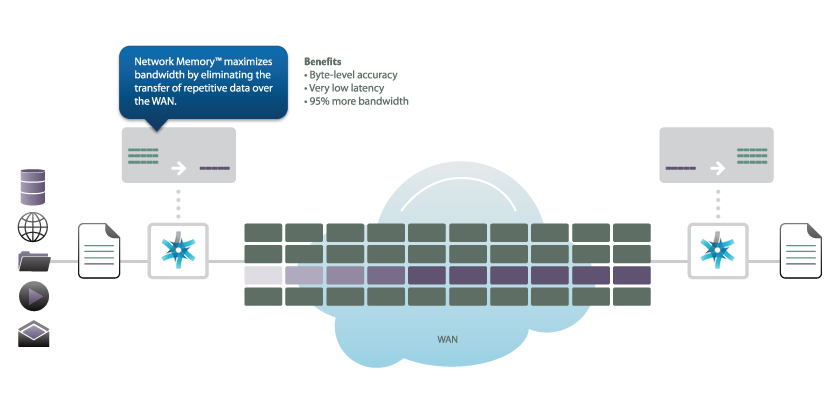At the heart of Silver Peak's WAN optimization heritage is data reduction capabilities. Silver Peak WAN compression and deduplication inspects all traffic in real-time, eliminating repetitive transmission of duplicate data.
Silver Peak data reduction inspects all inbound and outbound WAN traffic in real-time, storing a single local instance of data on each Silver Peak appliance. Short reference pointers are used to deliver repetitive information locally, eliminating the transfer of duplicate traffic over the WAN. If content is modified, the Silver Peak devices will detect the change at the byte level and update each device’s Network Memory accordingly. Only the modifications are sent across the WAN, improving scalability and response time. The end result: you get much more efficient bandwidth usage and LAN-like application performance over the WAN.
Data Reduction Improves WAN Performance

Features
- Works on all IP traffic. Addresses any transport protocol or application version.
- True byte-level granularity.
- Minimal insertion latency. Network Memory is ideal for real-time and interactive traffic
- No risk. Will not break current or future applications or corrupt data.
Benefits
- Lower telco and cloud costs. Avoid or delay costly WAN bandwidth upgrades by eliminating over 95% of WAN traffic. Lower cloud costs by over 50% by reducing data being transferred.
- Move data quicker between data centers, branch offices, remote locations and the cloud.
- Improve performance of centrally hosted storage and applications.
- Ensure success of strategic IT projects that rely on the WAN, like data replication, data center consolidation, virtualization, cloud, and big data.
Resources
-
Respected industry analyst Jim Metzler examines how SaaS and IaaS are changing the dynamics of the wide area network (WAN).
-
-
WAN deduplication (also known as disk-based data reduction) is a critical component of state-of-the-art WAN acceleration. By eliminating the transfer of repetitive data across the WAN, deduplication saves bandwidth and increases application throughput (from 2x to 100x under the right circumstances).
-
On the surface, different vendors’ Wide Area Network (WAN) deduplication solutions sound a lot alike. When one digs deeper, however, it becomes apparent that there are fundamental architectural differences that have a tangible impact on the performance of different applications across the WAN.
-
Data deduplication is one of the most significant technologies to impact the storage community in recent years. By identifying redundant data segments and storing only a single instance of information, this technology dramatically reduces storage space and allows more data to be protected over time.
-
Enterprises have long been battling the inherent performance limitations of Wide Area Networks (WANs) when delivering applications to remote offices. Caching emerged in the 1990’s as a potential way of addressing this problem, accelerating the performance of specific applications, such as web services, while reducing overall WAN traffic. While caching achieved reasonable success for a few short years, the market for these point products ultimately subsided as a result of several operational and functional limitations.
-
Encrypting SharePoint traffic, or for that matter any client-server traffic is even more important today than before; users work beyond the security of corporate walls while more security threats originate from within them. But encryption algorithms also cause problems by rendering application traffic largely immune to deduplication algorithms. Companies can end up with a secure application that responds like a slug over long distances.
-
United Drug Meets RPO, Reduces Disaster Recovery Costs
-
ARM Enhances Global Productivity with Silver Peak
-
Autodesk, Inc. is a world leader in 2D and 3D design and engineering software for the manufacturing, building and construction, and media and entertainment markets. Since its introduction of AutoCAD® software in 1982, Autodesk has developed the broadest portfolio of state-of-the-art software applications to help customers experience their ideas digitally before they are built. Fortune 1000 companies rely on Autodesk for the tools to design, visualize and simulate their ideas to save time and money, enhance quality and foster innovation for competitive advantage.
-
Gunnersen Moves Data Quickly Across Australia With Silver Peak